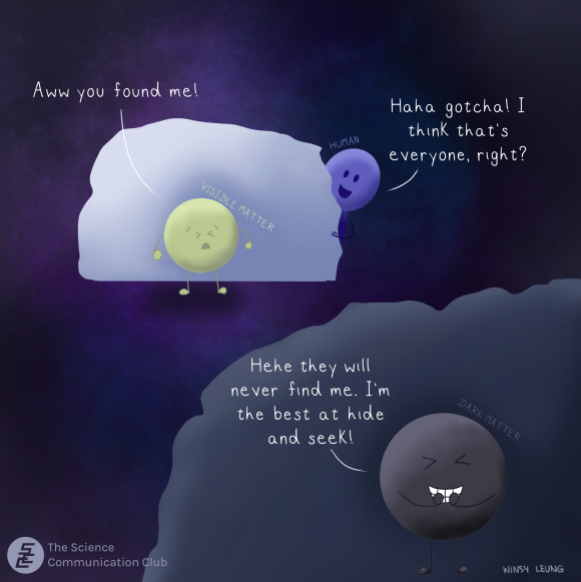
Written by Shoaib Shahid
Illustrated by Winsy-Leung
Let’s take a moment to imagine the vastness of our universe. All that is visible to us through our gigantic telescopes is unimaginable to our minds. Yet, all that is visible to us makes up a tiny slice of our universe – just 4 percent. The remaining is made up of dark energy and dark matter. Today, we focus on the illusive dark matter which constitutes around 23 percent of our universe. How did we discover matter we cannot see? How is dark matter different to ‘normal’ matter? Most importantly, what is dark matter? I’ll give you a hint for the last one. We don’t really know yet. Let’s forget you read that last sentence and quickly move on.
In 1933, Swiss astronomer Fritz Zwicky was sat looking at the Coma cluster through the – now decommissioned – Schmidt telescope. The Coma cluster is a large cluster of over a thousand galaxies. It is also where our story begins. Staring into the cluster, Zwicky noticed that the galaxies were rotating faster than expected. The velocity with which the visible matter revolves in any cluster depends on how much mass is in the cluster. The same is true for any object in gravitational rotation. Take our solar system as an example. Increase the mass of our sun and the Earth will start revolving faster under the effects of a stronger gravity. Hence, what Zwicky saw surprised him, as the mass of the Coma cluster was understood to be much less than what the velocity of its rotating mass was hinting to be. After some hefty calculations, Zwicky concluded that the Coma cluster should be four hundred times as massive as it is understood, given the motion of the galaxies he observed.
Nearly forty years after Zwicky’s discovery, we find Vera Rubin and Kent Ford hard at work at the Mount Wilson telescope. With some cutting-edge technology, they were peeking at the Andromeda galaxy, the closest galaxy to our Milky Way. It is just a measly 2.5 million light-years away. The duo measured the velocity of the stars moving outwards from the centre of the galaxy. It is fairly intuitive that the farther away from a mass an object is, the less gravity it experiences. If our Earth was farther away from the Sun, a year would certainly be longer than 365 days. Or a day would be longer than 24 hours, but let’s not fall into that rabbit hole. Yet again, physicists were surprised. The stars near the edge of Andromeda were revolving with nearly the same velocity as the ones closer to the centre!

In the decade that followed, forty to fifty galaxies were studied for this purpose. All of them showed the same law-defying behaviour. This discovery made no sense at the time. Physicists, who were pretty happy with the progress they had made so far in the century, were all on high alert. There were only two possible explanations for this phenomenon. Either there was some other form of mass keeping gravity constant throughout the galaxy or Einstein’s theory of gravity was not nearly as correct as we thought. And I don’t know about you, but I certainly will try out all other explanations before entertaining an explanation which involves Einstein being wrong. So, let’s entertain the first idea – the idea that there is some cloud of invisible mass permeating all our galaxies. Its gravity is what is keeping the velocity of stars consistent across their respective galaxies. If such a mass does exist, what would it be like?
- Invisible: First and foremost, dark matter would have to be invisible. It does not absorb or interact with light or any other form of radiation. Else, we would’ve seen it.
- Massive: Dark matter needs to have mass, so it can exert gravity on the visible matter, be it stars or galaxies.
- Shy: Dark matter should not be very friendly. It should interact weakly, with other matter and itself, if at all. Otherwise, we would be able to notice the effects of its interaction with visible matter. Its interactions with itself are difficult as dark matter considered to be spread out, not clumped. By being dispersed like this, it can keep the velocity of galaxies or stars near constant.
- Cold: A particle being cold means that it travels with a slow velocity. Our simulations show that, in the universe’s adolescence, slow dark matter was able to collect itself in small scale halos which then (gravitationally) attracted the visible matter to form galaxies and whatnot. Were dark matter to have a high velocity, it would not be able to form halos, and our universe would look quite different.
- Stable: Dark matter should be stable, and not quickly decay. Were it to decay into other particles, we would either be able to witness the visible matter content in our universe change, or at least see the radiation from the decay. I am sure it does not surprise you that we have seen neither scenario unfold.
We have spent considerable time laying out parameters for our search for dark matter. No particle in out famous standard model of physics, an index of all the particles thought to be in our universe, holds up against every criterion. So, we surely need a new particle in our equation. Several candidates have risen in the past few decades. I would like you to know one candidate in particular. The Weakly Interacting Massive Particle, or WIMP. These are hypothetical particles that, as their name suggests, interact weakly. This is because they interact only with the weak nuclear force and gravity. You know who I’ll be rooting for in this race to become dark matter. Regardless, it is awe-inspiring how much of our universe we have left to discover. At the very least, we are yet to understand around 96 per cent of our universe. Such a realization is both daunting and exciting. I suggest you be excited for we have so much to discover in our future.